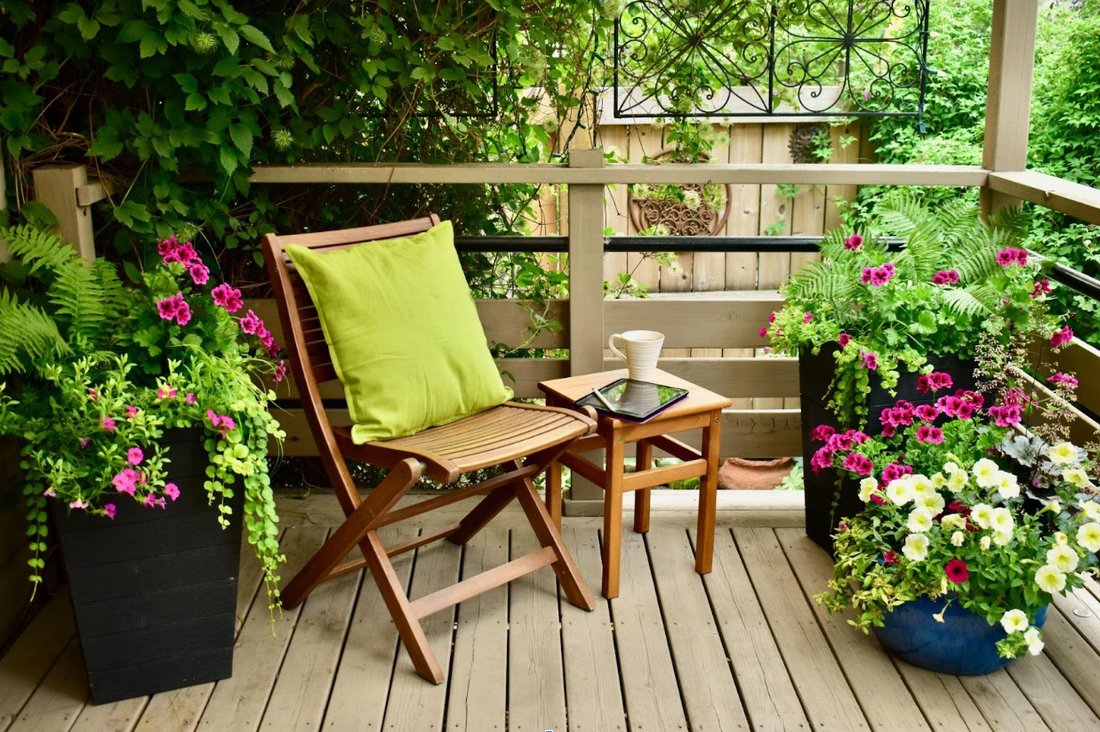Container gardening is a gratifying way to bring nature to your deck. But elevating your outdoor space while paying attention to California’s unique environmental concerns requires thoughtful consideration.
Here are a few tips to grow a vibrant, low-maintenance, fire-resistant, and drought-tolerant container garden on your California deck.
Why Container Gardening is Perfect for Decks
Decks are an ideal stage for container gardens. They offer direct exposure to sunlight and easy access to watering and maintenance.
Container gardens allow you to experiment with different plants, colors, and textures in a small, personal space. Plus, you can rearrange your selections as the summer morphs into fall, or if you have a sudden hankering for a succulent instead of an edible ornamental.

Deck-Friendly Care & Cleaning Guidelines
Containers can be heavy and messy. To protect the deck’s surface and avoid unnecessary cleanup, consider what your deck is made of and any specific care and cleaning needs as you plan your container garden design.
Composite Vs. Wood Decks:
Decks made from wood-alternative decking are noteworthy for their durability and easy maintenance, requiring just soap and water or a pass with a pressure washer.
But while wood-alternative decking resists rotting and staining, use caution when pairing it with rubber-backed materials on the bottom of container planters. These substances can discolor and lighten the composite decking surface.
Most decks are made from pressure-treated lumber. These wooden decks might have a lower upfront cost, but result in greater long-term costs due to more rigorous maintenance requirements. Wood decks are more susceptible to water damage from containers, and are also more dangerous in fire-prone areas.
To keep your deck looking as beautiful as your garden:
- Place containers on pot risers, saucers, or stands to keep containers off the deck surface and to allow for proper airflow and water drainage
- Standing water can speed up the deterioration of wood decks, so move containers after heavy rains to allow boards to dry thoroughly
- Avoid dragging containers to minimize scratching the deck’s surface
- Insulate pots or use double-walled containers to protect plant roots from composite boards (which can get quite hot in the summer sun)
- Consider the placement of containers. Avoid stressing the deck joists and boards by distributing containers evenly across the structure
Smart Soil and Watering Choices
Choosing the correct soil and watering practices for your pots is one key to creating a successful deck container garden. Here are some things to consider:
- Choose a potting mix that retains moisture while also draining well. Potting mix designed with containers in mind is available at most garden centers
- Avoid garden soil, which can compact and hinder drainage and root growth
- Self-watering containers or drip irrigation systems with automatic timing improve water efficiency for plants in your yard or on your deck.
- Water in the early morning or evening to minimize water loss from evaporation and hot weather
Drought-Resistance: Less Water, More Beauty
California is prone to droughts and water shortages, so choosing plants that minimize water consumption will lead to a garden that thrives. Fortunately, there are a plethora of plants that flourish in low-water conditions.
Drought-Tolerant Plant Ideas for Your Deck:
- Succulents such as yellow blossoms, hesperaloe, and cactus talons
- Wildflowers and grasses like chaparral, purple sage, and ceanothus
- Edible herbs, including thyme, rosemary, and oregano
- California native plants such as manzanita, lavender, and monkey flower
Fire-Wise Starts With The Right Pot and Plants
Developing a fire-resistant garden involves choosing fire-smart containers and plants suitable for California’s dry climate.
When it comes to containers, it’s generally best to avoid plastic and wood pots. Ceramic, terracotta, stone, metal, or fire-resistant composite containers make the best and safest choices in a fire-prone region. You may also need to secure a container in windy or fire-prone locations.
Leave ample space between your containers and house to minimize fire spread. Clean up dead leaves and debris regularly.
While no plant is entirely fireproof, some are more fire-resistant than others. Ideal plants include:
- Succulents (known for their high water content)
- Native desert plants, including buckwheat, Matilija poppies, and white sage
- Hardy bloomers with low flammability, such as daylilies, lantana, coreopsis
- Ornamental strawberries or creeping Jenny. These beautiful trailing plants have moisture-rich foliage
- Low-growing plants that prevent the buildup of dry fuel
Design Considerations That Add Appeal
Planning for your container garden should focus on design as well as functionality. Consider these tips to create an aesthetically pleasing deck container garden:
- Apply the rule of three design principle, which calls for grouping items in sets of threes (or odd numbers) to create a more visually appealing display. Group together small, medium, and large containers of the same shape and material to create harmony
- If you prefer order and repetition, group the same plant in multiple containers
- Blend three different types of plants, such as a tall ornamental grass, a medium height flowering plant, and a trailing ground cover
- Mix edible and ornamental plants for a quirky and fun addition
- Don’t forget the deck railing. Use vertical planters or hanging baskets to add visual appeal at eye level
- Add a few decorative touches, such as rocks, lanterns, and a small bistro table to bring the inside out
Maximize Your Deck and Garden with a Drainage System
If you have (or are planning to build) a two-story deck, consider installing a deck drainage system to double your garden enjoyment. Installed under the upper deck boards to catch and divert rainwater away, systems like Trex RainEscape create a completely dry, usable space below your deck and expand your living and storage space.
Benefits of Adding a Drainage System:
- Creates a protected area underneath the upper deck for entertaining, lounging, or even storing gardening tools and other plant care equipment
- Keeps furniture and flooring dry. Add lighting, ceiling fans, and even TVs to extend your living space
- Prevents moisture buildup that can adversely affect both plants and decking materials.
- Allows you to easily capture and recycle rainwater and deck runoff using a rain barrel for water storage and garden irrigation
- Adds long-term value and functionality to any outdoor living space
Enjoy Your Creation
Container gardening on a deck is an enjoyable way to bring nature up close in your own unique style. It only takes a few pots and some careful planning to create a serene space fit for alone time or a lush, colorful feast for the eyes. Transform your deck space with a container garden and enjoy your yard year-round with family and friends.
Ready to get started? Explore our collection of drought-tolerant, fire-resistant plants suitable for containers that will bring your vision to life.
About the Author
Dave Kile is the owner of IBP, LLC, the company behind some of the decking industry’s most successful innovations, including Trex® RainEscape®, Trex® Protect™ and Trex® Seal™. He got his start in the construction business in the early 1990s as an outside sales representative for 84 Lumber. He went on to spend more than a decade in sales and sales management with Capital Lumber, the leading distributor of building materials, before starting IBP in 2003. Over the past three decades, he has achieved incremental success by immersing himself in the industry, listening to customers and bringing new products to market that improve efficiency and effectiveness.




